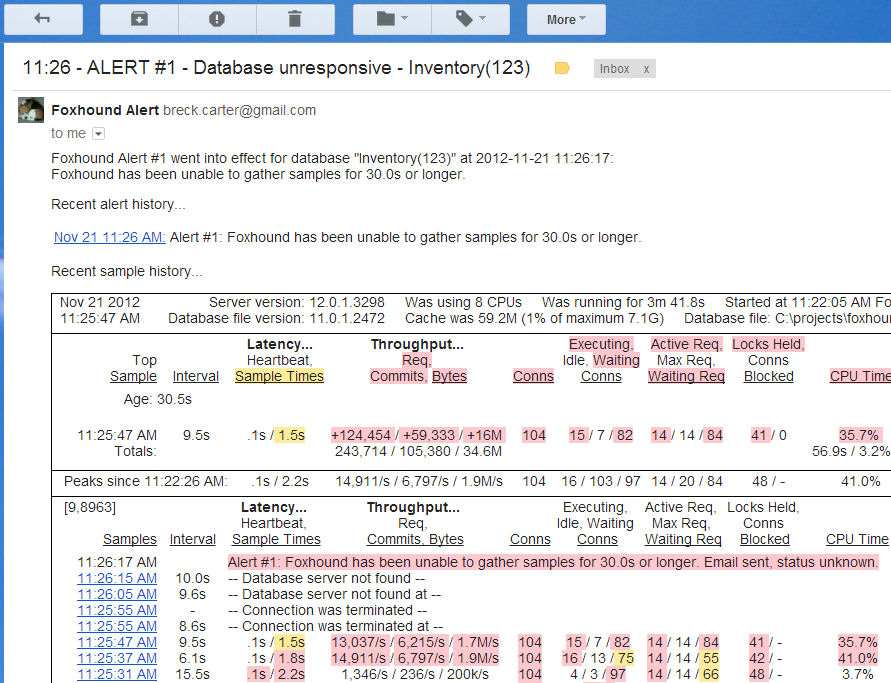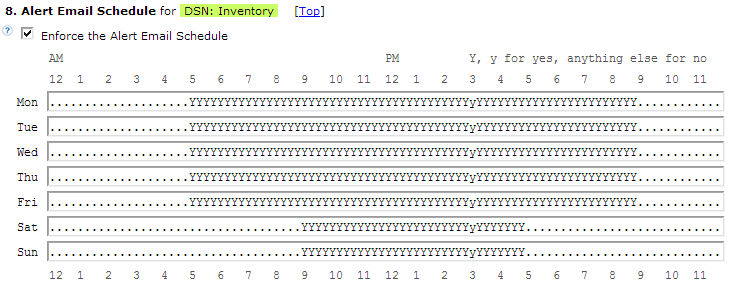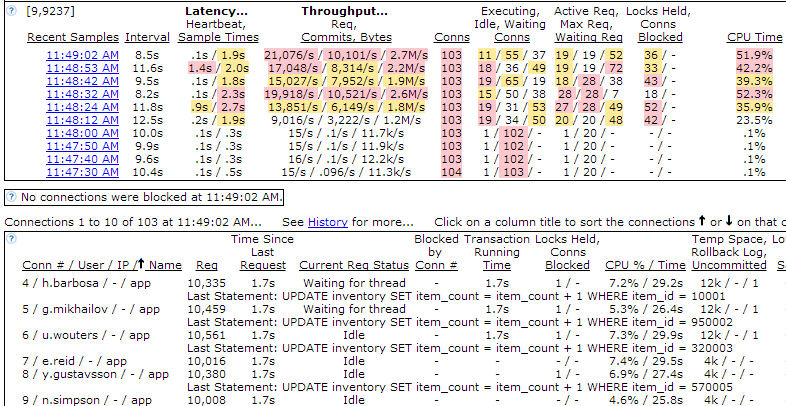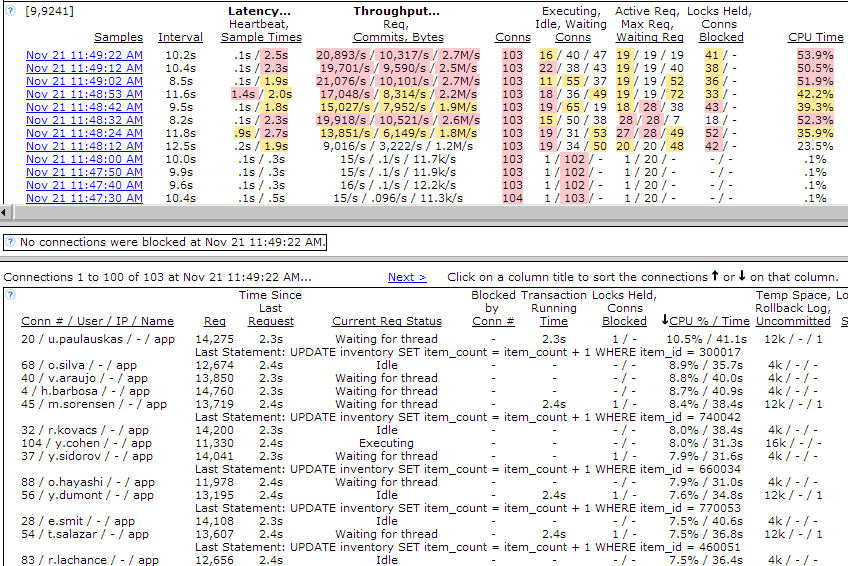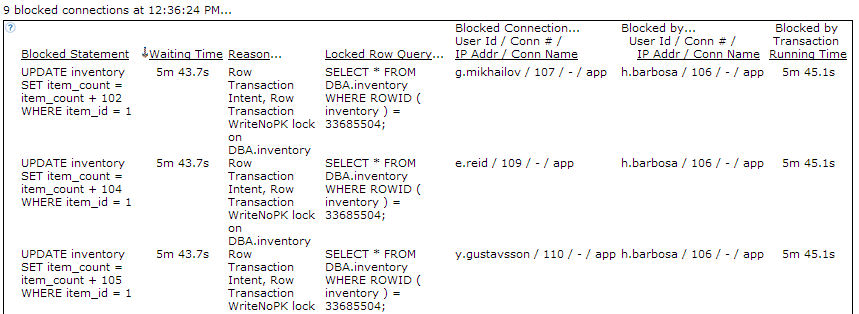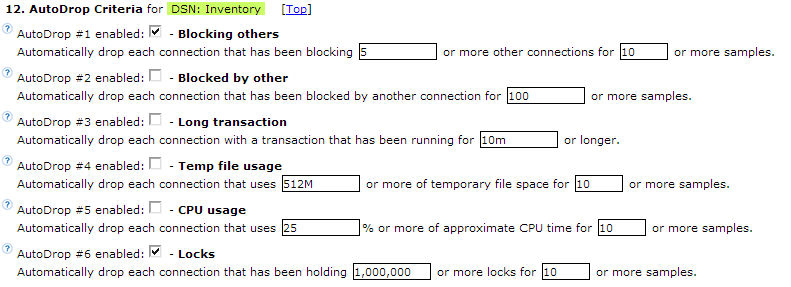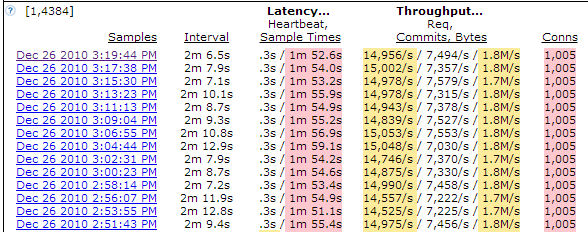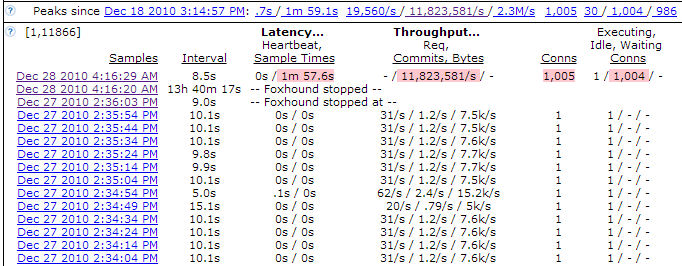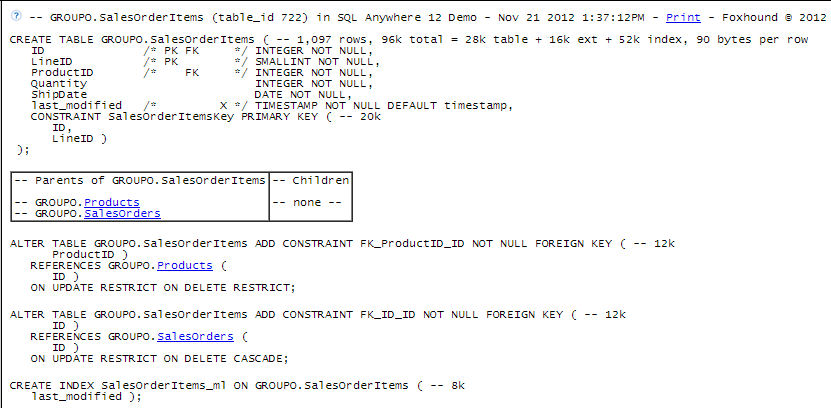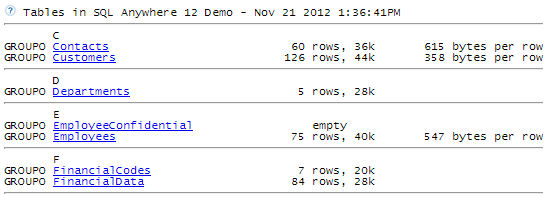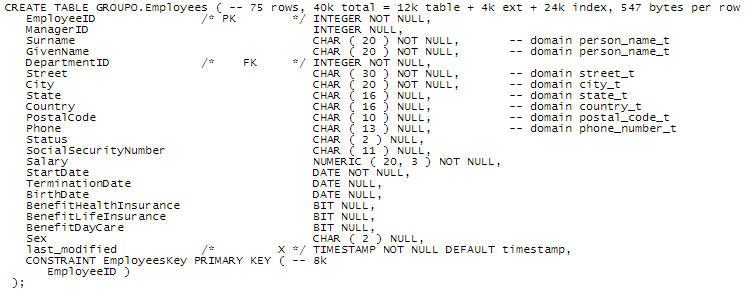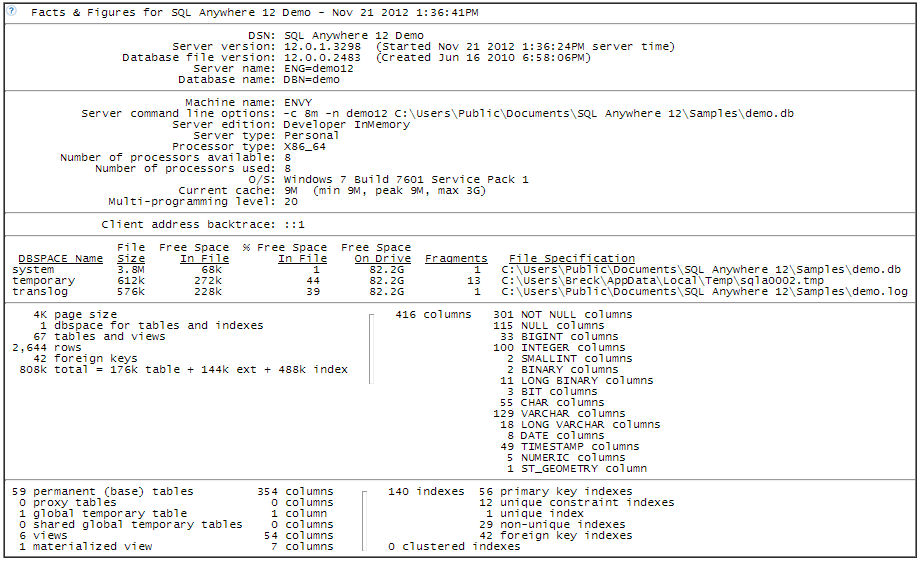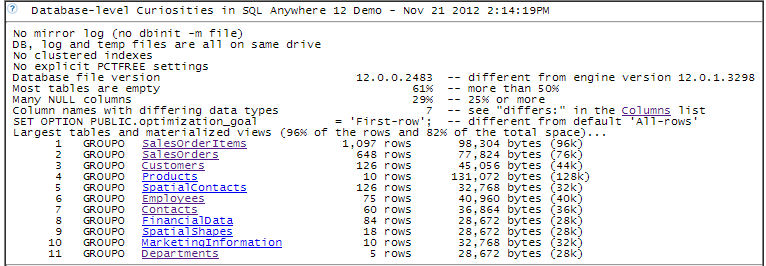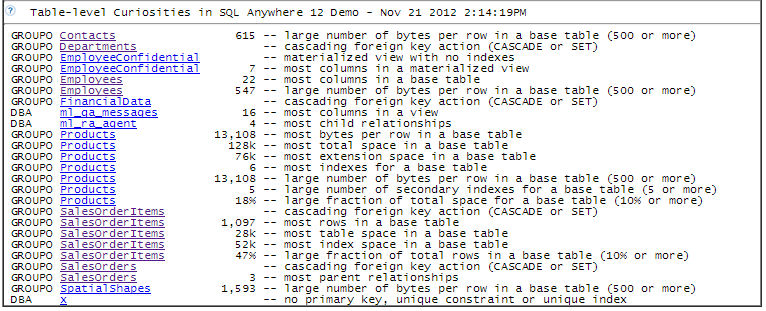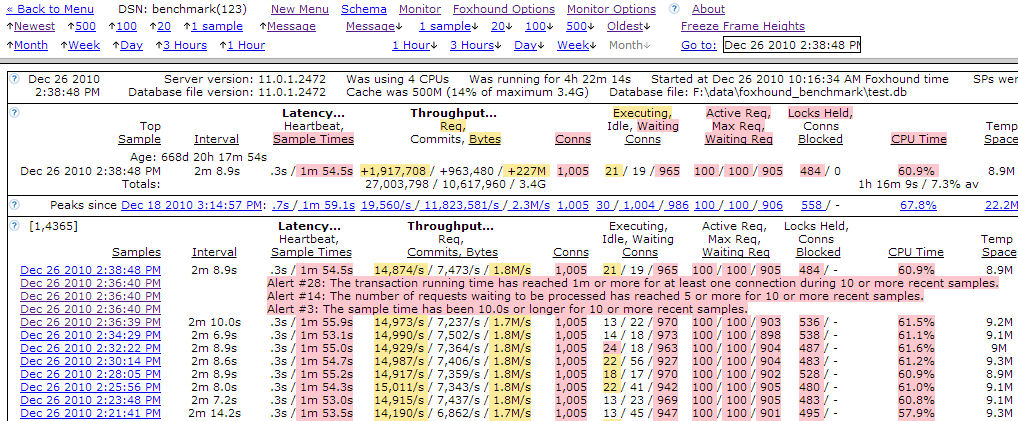|
||||||||||||||||||||||||||||||||||||||||||||||||||||||||||||||||||||||||||||||||||||||||||||||||||||||||||
|
|
||||||||||||||||||||||||||||||||||||||||||||||||||||||||||||||||||||||||||||||||||||||||||||||||||||||||||
What ... ? (general)What is Foxhound? (and how do I get a copy of Foxhound?)What is SQL Anywhere? What are the differences among the different editions of Foxhound: Rental, Basic and Extended? What are the Foxhound system requirements? What are the differences among all the activation keys? What is a "Basic Initial Activation Key"? What is a "Basic To Extended Activation Upgrade Key"? What is a "Basic Version Upgrade Key 1.0 to 2.0"? What is a "Basic Version Upgrade Key 1.1 to 2.0"? What is an "Extended Initial Activation Key"? What is an "Extended Version Upgrade Key 1.0 to 2.0"? What is an "Extended Version Upgrade Key 1.1 to 2.0"? What is a "Rental Key"? What is the Foxhound End-User License Agreement (EULA)? What is the upgrade policy for installing new builds of Foxhound? What happens when a copy of Foxhound expires? What environment variables are used by Foxhound? What does the connection-level "Transaction Running Time" tell me? What HTTP port should I use for Foxhound? What is the foxhound2.db ... .ORIGINAL_COPY file? What's new in Foxhound 2.0? |
||||||||||||||||||||||||||||||||||||||||||||||||||||||||||||||||||||||||||||||||||||||||||||||||||||||||||
|
|
||||||||||||||||||||||||||||||||||||||||||||||||||||||||||||||||||||||||||||||||||||||||||||||||||||||||||
| [ Top ] | ||||||||||||||||||||||||||||||||||||||||||||||||||||||||||||||||||||||||||||||||||||||||||||||||||||||||||
|
Question: What is Foxhound?
Answer: Foxhound is two products in one: it is both a database monitor and a schema troubleshooter for SQL Anywhere. A database monitor is a computer program that measures the activity of a database management system and displays those measurements in a meaningful way, so that you can easily see that everything's OK or quickly learn about problems and threats to performance and availability. A monitor can also send email alerts when something goes wrong. A schema troubleshooter is a computer program that performs a static analysis of the tables, columns, indexes, foreign key relationships and other objects in the database, displays those objects in a way that's easy to understand and easy to navigate, together with various facts, figures and curiosities which may be problems that need attention.
Foxhound Features
See also...
|
||||||||||||||||||||||||||||||||||||||||||||||||||||||||||||||||||||||||||||||||||||||||||||||||||||||||||
|
|
||||||||||||||||||||||||||||||||||||||||||||||||||||||||||||||||||||||||||||||||||||||||||||||||||||||||||
| [ Top ] | ||||||||||||||||||||||||||||||||||||||||||||||||||||||||||||||||||||||||||||||||||||||||||||||||||||||||||
|
Question: What is SQL Anywhere?
Answer:
"SQL Anywhere is a relational database management system (RDBMS) product from the company Sybase iAnywhere, a subsidiary of Sybase."
"SQL Anywhere is a comprehensive suite of solutions that provides data management, synchronization and data exchange
technologies that enable the rapid development and deployment of database-powered applications in remote and mobile environments."
See also...
|
||||||||||||||||||||||||||||||||||||||||||||||||||||||||||||||||||||||||||||||||||||||||||||||||||||||||||
|
|
||||||||||||||||||||||||||||||||||||||||||||||||||||||||||||||||||||||||||||||||||||||||||||||||||||||||||
| [ Top ] | ||||||||||||||||||||||||||||||||||||||||||||||||||||||||||||||||||||||||||||||||||||||||||||||||||||||||||
|
Question: What are the differences among the different editions of Foxhound: Rental, Basic and Extended?
Answer: The following chart is subject to change.
* This limit on connections applies to all versions and editions of SQL Anywhere target databases and servers. The actual limit is 101 connections when you count the connection from Foxhound itself. Internal connections (e.g., connections made by events and web services) are counted in the total. ** This limit on physical CPUs does not apply to SQL Anywhere version 5.5, 6, 7, 8 or 9 target databases and servers. Also, it applies to the number of physical processors as given by the NumPhysicalProcessorsUsed server property, not the number of logical processors shown by "Using n CPUs" value in the Foxhound Database Monitor. For example, a single Intel Pentium 4 processor counts as 1 physical processor even though the separate HyperThreading units may show up as "Using 2 CPUs". Similarly, a single Intel Core2 Quad processor also counts as only 1 physical processor even though it may show up as "Using 4 CPUs". *** This restriction on SQL Anywhere editions does not apply to SQL Anywhere target databases and servers earlier than version 11.0.1, which is when SQL Anywhere introduced the notion of different editions. **** The Extended Edition allows up to 10 separate copies of the Foxhound database to be created, and these separate copies may be started at the same time using separate SQL Anywhere servers running on the same physical computer or on separate computers on the same local network. The following runtime server names are allowed: foxhound2 (the default) and foxhound2b through foxhound2j.
See also...
|
||||||||||||||||||||||||||||||||||||||||||||||||||||||||||||||||||||||||||||||||||||||||||||||||||||||||||
|
|
||||||||||||||||||||||||||||||||||||||||||||||||||||||||||||||||||||||||||||||||||||||||||||||||||||||||||
| [ Top ] | ||||||||||||||||||||||||||||||||||||||||||||||||||||||||||||||||||||||||||||||||||||||||||||||||||||||||||
|
Question: What are the Foxhound system requirements?
Answer: 1. Windows - Foxhound works with target databases running on other operating systems but the Foxhound engine itself only runs on Windows, and has been tested on Microsoft Windows 7. 2. ODBC - Foxhound itself uses ODBC to connect to your target databases. You don't necessarily need ODBC installed on the servers running your target databases, and you can specify DSN-less connections for Foxhound by using the "String" tab on the main menu page. 3. Chrome, Firefox, IE - The Foxhound client has been tested with the latest browser versions, currently Google Chrome 21, Firefox 15 and Internet Explorer 9. 4. JavaScript - Foxhound needs "JavaScript" or "Active scripting" to be enabled in your browser. 5. SQL Anywhere version 5.5.5.2787 through version 12 for target databases - If you have any target databases running on SQL Anywhere 5.5, you may have to upgrade them to 5.5.5.2787 for Foxhound to work properly with them. 6. SQL Anywhere 12.0.1.3298 or later for Foxhound - Foxhound works with target databases using 5.5 to 12 of SQL Anywhere but the Foxhound engine itself needs the 32-bit or 64-bit version of SQL Anywhere 12.0.1.3298 or later to run. 7. SQLANY12 - The delivered *.bat files expect that the SQLANY12 environment variable points to SQL Anywhere 12. If that is not the case you may have to modify the *.bat files. Here is the default setting on Windows XP, Vista and Windows 7: SET SQLANY12=C:\Program Files\SQL Anywhere 128. FOXHOUND2 - The delivered *.bat files expect that the FOXHOUND2 environment variable will be created by the Foxhound installation (which will happen by default). If that is not the case you may have to modify the *.bat files. Here is the default setting for Windows XP: SET FOXHOUND2=C:\Documents and Settings\All Users\Application Data\RisingRoad\Foxhound2\and for Windows Vista and Windows 7 it is this: SET FOXHOUND2=C:\ProgramData\RisingRoad\Foxhound2\ 9. Disk space - When re-installing or upgrading Foxhound, 60% or more extra disk space may be required during the post-setup process. The "60% or more" figure applies to the amount of disk space occupied by the existing Foxhound installation, not the total used disk space on the drive.
See also...
|
||||||||||||||||||||||||||||||||||||||||||||||||||||||||||||||||||||||||||||||||||||||||||||||||||||||||||
|
|
||||||||||||||||||||||||||||||||||||||||||||||||||||||||||||||||||||||||||||||||||||||||||||||||||||||||||
| [ Top ] | ||||||||||||||||||||||||||||||||||||||||||||||||||||||||||||||||||||||||||||||||||||||||||||||||||||||||||
|
Question: What are the differences among all the activation keys?
Answer: An Activation Key (also known as a Registration Key) is a code that lets you use a copy of Foxhound that you have already installed. Activation Keys are available for purchase here, and the Foxhound Activation page will tell you which kind of key you need... or you can look use the following table:
See also...
|
||||||||||||||||||||||||||||||||||||||||||||||||||||||||||||||||||||||||||||||||||||||||||||||||||||||||||
|
|
||||||||||||||||||||||||||||||||||||||||||||||||||||||||||||||||||||||||||||||||||||||||||||||||||||||||||
| [ Top ] | ||||||||||||||||||||||||||||||||||||||||||||||||||||||||||||||||||||||||||||||||||||||||||||||||||||||||||
|
Question: What is a "Basic Initial Activation Key"?
Answer: A Basic Initial Activation Key is a code that may be used to activate Foxhound Version 2 as an Basic Edition copy after
In both cases the Foxhound Activation page will appear automatically when you start Foxhound, and entering a Basic Initial Activation Key will be one of the alternatives. A Basic Initial Activation Key may also be used to change the Rental Edition to the Basic Edition; see the Renew or Upgrade Foxhound button on the About page.
You can purchase a Basic Initial Activation Key here:
See also...
|
||||||||||||||||||||||||||||||||||||||||||||||||||||||||||||||||||||||||||||||||||||||||||||||||||||||||||
|
|
||||||||||||||||||||||||||||||||||||||||||||||||||||||||||||||||||||||||||||||||||||||||||||||||||||||||||
| [ Top ] | ||||||||||||||||||||||||||||||||||||||||||||||||||||||||||||||||||||||||||||||||||||||||||||||||||||||||||
|
Question: What is a "Basic To Extended Activation Upgrade Key"?
Answer: A Basic To Extended Activation Upgrade Key is a code that may be used to change an existing copy of Foxhound Version 2 from the Basic Edition to the Extended Edition.
You can purchase a Basic To Extended Activation Upgrade Key here:
See also...
|
||||||||||||||||||||||||||||||||||||||||||||||||||||||||||||||||||||||||||||||||||||||||||||||||||||||||||
|
|
||||||||||||||||||||||||||||||||||||||||||||||||||||||||||||||||||||||||||||||||||||||||||||||||||||||||||
| [ Top ] | ||||||||||||||||||||||||||||||||||||||||||||||||||||||||||||||||||||||||||||||||||||||||||||||||||||||||||
|
Question: What is a "Basic Version Upgrade Key 1.0 to 2.0"?
Answer: A Basic Version Upgrade Key 1.0 to 2.0 is a code that may be used to activate a Basic Edition copy of Foxhound that was originally purchased as Version 1.0, after it has been upgraded to Version 2. In this case the Foxhound Activation page will appear automatically when you start Foxhound, and it will request a Basic Version Upgrade Key 1.0 to 2.0.
You can purchase a Basic Version Upgrade Key 1.0 to 2.0 here:
See also...
|
||||||||||||||||||||||||||||||||||||||||||||||||||||||||||||||||||||||||||||||||||||||||||||||||||||||||||
|
|
||||||||||||||||||||||||||||||||||||||||||||||||||||||||||||||||||||||||||||||||||||||||||||||||||||||||||
| [ Top ] | ||||||||||||||||||||||||||||||||||||||||||||||||||||||||||||||||||||||||||||||||||||||||||||||||||||||||||
|
Question: What is a "Basic Version Upgrade Key 1.1 to 2.0"?
Answer: A Basic Version Upgrade Key 1.1 to 2.0 is a code that may be used to activate a Basic Edition copy of Foxhound that was originally purchased as Version 1.1, after it has been upgraded to Version 2. In this case the Foxhound Activation page will appear automatically when you start Foxhound, and it will request a Basic Version Upgrade Key 1.1 to 2.0.
You can purchase a Basic Version Upgrade Key 1.1 to 2.0 here:
See also...
|
||||||||||||||||||||||||||||||||||||||||||||||||||||||||||||||||||||||||||||||||||||||||||||||||||||||||||
|
|
||||||||||||||||||||||||||||||||||||||||||||||||||||||||||||||||||||||||||||||||||||||||||||||||||||||||||
| [ Top ] | ||||||||||||||||||||||||||||||||||||||||||||||||||||||||||||||||||||||||||||||||||||||||||||||||||||||||||
|
Question: What is an "Extended Initial Activation Key"?
Answer: An Extended Initial Activation Key is a code that may be used to activate Foxhound Version 2 as an Extended Edition copy after
In both cases the Foxhound Activation page will appear automatically when you start Foxhound, and entering an Extended Initial Activation Key will be one of the alternatives. An Extended Initial Activation Key may also be used to change the Rental Edition to the Extended Edition; see the Renew or Upgrade Foxhound button on the About page.
You can purchase an Extended Initial Activation Key here:
See also...
|
||||||||||||||||||||||||||||||||||||||||||||||||||||||||||||||||||||||||||||||||||||||||||||||||||||||||||
|
|
||||||||||||||||||||||||||||||||||||||||||||||||||||||||||||||||||||||||||||||||||||||||||||||||||||||||||
| [ Top ] | ||||||||||||||||||||||||||||||||||||||||||||||||||||||||||||||||||||||||||||||||||||||||||||||||||||||||||
|
Question: What is an "Extended Version Upgrade Key 1.0 to 2.0"?
Answer: An Extended Version Upgrade Key 1.0 to 2.0 is a code that may be used to activate an Extended Edition copy of Foxhound that was originally purchased as Version 1.0, after it has been upgraded to Version 2. In this case the Foxhound Activation page will appear automatically when you start Foxhound, and it will request an Extended Version Upgrade Key 1.0 to 2.0.
You can purchase an Extended Version Upgrade Key 1.0 to 2.0 here:
See also...
|
||||||||||||||||||||||||||||||||||||||||||||||||||||||||||||||||||||||||||||||||||||||||||||||||||||||||||
|
|
||||||||||||||||||||||||||||||||||||||||||||||||||||||||||||||||||||||||||||||||||||||||||||||||||||||||||
| [ Top ] | ||||||||||||||||||||||||||||||||||||||||||||||||||||||||||||||||||||||||||||||||||||||||||||||||||||||||||
|
Question: What is an "Extended Version Upgrade Key 1.1 to 2.0"?
Answer: An Extended Version Upgrade Key 1.1 to 2.0 is a code that may be used to activate an Extended Edition copy of Foxhound that was originally purchased as Version 1.1, after it has been upgraded to Version 2. In this case the Foxhound Activation page will appear automatically when you start Foxhound, and it will request an Extended Version Upgrade Key 1.1 to 2.0.
You can purchase an Extended Version Upgrade Key 1.1 to 2.0 here:
See also...
|
||||||||||||||||||||||||||||||||||||||||||||||||||||||||||||||||||||||||||||||||||||||||||||||||||||||||||
|
|
||||||||||||||||||||||||||||||||||||||||||||||||||||||||||||||||||||||||||||||||||||||||||||||||||||||||||
| [ Top ] | ||||||||||||||||||||||||||||||||||||||||||||||||||||||||||||||||||||||||||||||||||||||||||||||||||||||||||
|
Question: What is a "Rental Key"?
Answer: A Rental Key is a code that may be used to activate Foxhound Version 2 as a Rental Edition copy after
In both cases the Foxhound Activation page will appear automatically when you start Foxhound, and entering a Rental Key will be one of the alternatives. A Rental Key may also be used to extend or renew the rental period for an existing installation of the Rental Edition for an additional or subsequent 30-day period. A different Rental Key is required for each 30-day period; see the Renew or Upgrade Foxhound button on the About page.
You can purchase a Rental Key here:
See also...
|
||||||||||||||||||||||||||||||||||||||||||||||||||||||||||||||||||||||||||||||||||||||||||||||||||||||||||
|
|
||||||||||||||||||||||||||||||||||||||||||||||||||||||||||||||||||||||||||||||||||||||||||||||||||||||||||
| [ Top ] | ||||||||||||||||||||||||||||||||||||||||||||||||||||||||||||||||||||||||||||||||||||||||||||||||||||||||||
|
Question: What is the Foxhound End-User License Agreement (EULA)?
Answer: RisingRoad - 3QC Inc. License Terms Foxhound Version 2 By using the software, you accept the following terms. IF YOU DO NOT ACCEPT THEM, DO NOT USE THE SOFTWARE. 1. No-Nonsense License Agreement The Foxhound software is protected by United States and Canadian copyright law and international copyright treaty provisions. Therefore, you must treat Foxhound just like a book, except that you may copy it onto a computer to be used and you may make archival copies of Foxhound for the sole purpose of backing-up our software and your data and protecting your investment from loss. By saying "just like a book," RisingRoad means, for example, that one copy of Foxhound may be executed on any number of computers, and may be freely moved from one computer to another, so long as there is no possibility of it being executed on one computer while it's being executed on another. By saying "one copy of Foxhound", RisingRoad means a copy of the Foxhound software that has been activated by the application of one single unique registration key obtained from RisingRoad. Just like one copy of a book can't be read by two different people in two different places at the same time, neither can one copy of Foxhound be executed on two different computers at the same time. (Unless, of course, this License Agreement has been violated.) 2. Use on a Network and the Internet In the case of the Rental and Basic Editions, one copy of Foxhound may be executed on a computer attached to a local area network and/or the internet, with multiple users accessing the single Foxhound database from browsers running on different computers. The "just like a book" analogy begins to weaken at this point, but it still applies if you think of more than one person reading the same book over someone else's shoulder... it's still one copy of the book, and one copy of Foxhound executing. In the case of the Extended Edition, up to 10 copies of the Foxhound database may be created and executed on a computer attached to a local area network and/or the internet, with multiple users accessing these Foxhound databases from browsers running on different computers. These multiple copies must be launched according to the method shown in the documentation, using one single installed copy of Foxhound. 3. Further Explanation of Copyright Law and the Scope of This License Statement You may not download or transmit your copy of Foxhound electronically (either by direct connection or telecommunication transmission) for the purpose of executing it on multiple computers at the same time. You may transfer all of your rights to use your copy of Foxhound to another person, provided that you transfer to that person (or destroy) all of the software and documentation provided in this package, together with all copies, tangible or intangible, including copies in RAM or installed on a disk, as well as all back-up copies. Remember, once you transfer your copy of Foxhound, it may only be executed on the single computer to which it is transferred and, of course, only in accordance with copyright law and international treaty provisions. Except as stated in this paragraph, you may not otherwise transfer, rent, lease, sub-license, time-share, or lend the Foxhound software or documentation. Your use of Foxhound is limited to acts that are essential steps in the use of Foxhound on your computer as described in the documentation. You may not otherwise modify, alter, adapt, merge, decompile or reverse-engineer Foxhound, and you may not remove or obscure RisingRoad copyright notices. 6. Disclaimer of Warranty The software is licensed "as is". You bear the risk of using it. RisingRoad gives no express warranties, guarantees or conditions. RisingRoad excludes the implied warranties of merchantability, fitness for a particular purpose and non-infringement.
See also...
|
||||||||||||||||||||||||||||||||||||||||||||||||||||||||||||||||||||||||||||||||||||||||||||||||||||||||||
|
|
||||||||||||||||||||||||||||||||||||||||||||||||||||||||||||||||||||||||||||||||||||||||||||||||||||||||||
| [ Top ] | ||||||||||||||||||||||||||||||||||||||||||||||||||||||||||||||||||||||||||||||||||||||||||||||||||||||||||
|
Question: What is the upgrade policy for installing new builds of Foxhound?
Answer: At present, you can install a new build of Foxhound on top of an old one, and your data will be copied and upgraded. In the future, limitations may be applied to the installation of new builds; e.g., the end of the "Free Upgrade" period. These limitations are not yet fully defined, but they will take the form of requiring you to provide a new registration key to activate the new build.
See also...
|
||||||||||||||||||||||||||||||||||||||||||||||||||||||||||||||||||||||||||||||||||||||||||||||||||||||||||
|
|
||||||||||||||||||||||||||||||||||||||||||||||||||||||||||||||||||||||||||||||||||||||||||||||||||||||||||
| [ Top ] | ||||||||||||||||||||||||||||||||||||||||||||||||||||||||||||||||||||||||||||||||||||||||||||||||||||||||||
|
Question: What happens when a copy of Foxhound expires?
Answer: If your installed Rental copy of Foxhound expires, you will be still able to view the History portion of the Monitor Database feature, as well as view your Foxhound Options and Alerts Criteria settings. However, the Monitor Database process will not gather any new samples and by implication the Alert process will cease to function. Also, the Display Schema feature will be disabled. Other limitations may be applied to the installation of new builds; e.g., the end of the "Free Upgrade" period. These limitations are not yet fully defined, but they will take the form of requiring you to provide a new registration key to activate the new build.
See also...
|
||||||||||||||||||||||||||||||||||||||||||||||||||||||||||||||||||||||||||||||||||||||||||||||||||||||||||
|
|
||||||||||||||||||||||||||||||||||||||||||||||||||||||||||||||||||||||||||||||||||||||||||||||||||||||||||
| [ Top ] | ||||||||||||||||||||||||||||||||||||||||||||||||||||||||||||||||||||||||||||||||||||||||||||||||||||||||||
|
Question: What environment variables are used by Foxhound?
Answer: FOXHOUND2 is very important. It is set by the Foxhound InstallShield setup program to contain the drive and path of the folder where Foxhound is installed. It is then used in most of the Windows command files that are executed by the Foxhound shortcuts. For example, the "Start - Foxhound2 - Start Foxhound via Chrome" executes the $start_foxhound2_chrome.bat file which contains the command CD /D "%FOXHOUND2%". Normally you do not have to enter or change the FOXHOUND2 environment variable, but if you do, here's how: FOXHOUND2BIN is optional and rarely used. You can set it to Bin32 if you want to start Foxhound using the 32-bit version of SQL Anywhere 12 even if the 64-bit version is available. Values other than Bin32 have no effect. The default action (if FOXHOUND2BIN is not set to Bin32) is to start Foxhound using the 64-bit version of SQL Anywhere if it is installed, otherwise use the 32-bit version. No automatic process sets or changes the FOXHOUND2BIN environment variable, it's all up to you: FOXHOUND2UPGRADE is optional and rarely used. If it is set, it is used as the initial value for the FOXHOUND2UPGRADE setting in the post-setup process the next time you reinstall or upgrade Foxhound. The post-setup process will prompt you to provide a different value if one is desired: The default action (if FOXHOUND2UPGRADE is not set to any value) is to use the the value ALL as the initial value, which you can change as shown above; see How do the different FOXHOUND2UPGRADE values work? No automatic process sets or changes the FOXHOUND2UPGRADE environment variable, it's all up to you:
See also...
|
||||||||||||||||||||||||||||||||||||||||||||||||||||||||||||||||||||||||||||||||||||||||||||||||||||||||||
|
|
||||||||||||||||||||||||||||||||||||||||||||||||||||||||||||||||||||||||||||||||||||||||||||||||||||||||||
| [ Top ] | ||||||||||||||||||||||||||||||||||||||||||||||||||||||||||||||||||||||||||||||||||||||||||||||||||||||||||
|
Question: What does the connection-level "Transaction Running Time" tell me?
Answer: A long Transaction Running Time means the connection hasn't performed a COMMIT or ROLLBACK for a long time since starting the current database transaction. Note that each connection can only have one database transaction in progress at any given point in time; there is no such thing as "nested transactions", and if an application wants to run two different database transactions at the same time it must use two different database connections. If the Locks Held number is larger than zero, it means other connections may be prevented from updating (and possibly even reading) rows this connection has locked; if that actually happens, this connection's Conn # will show up in the Blocked by Conn # for the other connections. If the Uncommitted number is larger than Locks Held, it may be that this connection is repeatedly updating the same rows without committing the changes.
|
||||||||||||||||||||||||||||||||||||||||||||||||||||||||||||||||||||||||||||||||||||||||||||||||||||||||||
|
|
||||||||||||||||||||||||||||||||||||||||||||||||||||||||||||||||||||||||||||||||||||||||||||||||||||||||||
| [ Top ] | ||||||||||||||||||||||||||||||||||||||||||||||||||||||||||||||||||||||||||||||||||||||||||||||||||||||||||
|
Question: What HTTP port should I use for Foxhound?
Answer: Port 4950 is officially registered to the "Sybase Server Monitor" which is the SQL Anywhere Monitor that ships in the box with SQL Anywhere. If you're not already running the SQL Anywhere Monitor on that port, consider using 4950 for Foxhound. Alternatively, consider using one of the "Dynamic and/or Private Ports" in the range 49152 through 65535.
See also...
|
||||||||||||||||||||||||||||||||||||||||||||||||||||||||||||||||||||||||||||||||||||||||||||||||||||||||||
|
|
||||||||||||||||||||||||||||||||||||||||||||||||||||||||||||||||||||||||||||||||||||||||||||||||||||||||||
| [ Top ] | ||||||||||||||||||||||||||||||||||||||||||||||||||||||||||||||||||||||||||||||||||||||||||||||||||||||||||
|
Question: What is the foxhound2.db ... .ORIGINAL_COPY file?
Answer: [ It is a copy of the foxhound2.db file as delivered; i.e., before anything was copied from the old Foxhound database including the activation status. It is created in foxhound2\setup folder by the $post_setup.bat command file after the InstallShield setup runs but before the post-setup data upgrade process runs.
|
||||||||||||||||||||||||||||||||||||||||||||||||||||||||||||||||||||||||||||||||||||||||||||||||||||||||||
|
|
||||||||||||||||||||||||||||||||||||||||||||||||||||||||||||||||||||||||||||||||||||||||||||||||||||||||||
| [ Top ] | ||||||||||||||||||||||||||||||||||||||||||||||||||||||||||||||||||||||||||||||||||||||||||||||||||||||||||
Question: What's new in Foxhound 2.0?
New Feature: AutoDrop [Top] The AutoDrop process is available in the Extended Edition of Foxhound Version 2. New Feature: Schedules [Top] The Schedules feature is available in the Extended Edition of Foxhound Version 2. New Feature: Jumping Through History [Top] The Jumping Through History feature is available in all editions of Foxhound Version 2.
Enhancements... [Top]
Enhancement: Monitor Tab Shows More Data In Less Space [Top] The list of target databases on the Monitor tab of the Foxhound Menu page has been redesigned to reduce the amount of horizontal and vertical scrolling required when you are monitoring a lot of databases. Enhancement: Up and Down Arrows On The History Menu [Top] The new Enhancement: Latency and Throughput Highlighted [Top] The columns on the Monitor and History pages have been rearranged to highlight the Latency and Throughput numbers: Enhancement: Connection Identification Columns Rearranged [Top] The four columns which identify each connection have been rearranged to put the connection number first: Conn # / User / IP / Name Enhancement: Email Status Displayed In Alert Messages [Top] Alert messages include the email status on the Monitor and History displays, and on the Active Alerts section of Foxhound Menu Monitor Tab. Enhancement: Initial 'Last Statement:' Sort Order Changed To DESC [Top] The initial sort order when you first click on the 'Last Statement:' title text in the current connection list in the Monitor and History pages has been changed from ASC to DESC so non-empty values appear at the top of the list. Enhancement: Click here to sort on: Last Statement or AutoDrop message [Top] When there are a lot of connections showing on the Monitor or History pages, the column titles "Last Statement" and "AutoDropped" might not appear on screen so there's nothing to click on if you want to sort those values to the top. This has been fixed by adding clickable text to the connection section heading: "Click here to sort on: Last Statement or AutoDrop message." Enhancement: Tip "Click on a column title to sort the connections ..." [Top] The Monitor and History pages now display this tip at the top of the list of current connections: "Click on a column title to sort the connections ..." Enhancement: New Design For The Foxhound And Monitor Options Pages [Top] The Foxhound Options and Monitor Options pages have both been redesigned to be easier to use. Enhancement: Color Highlighting For "[Default Options]" On The Monitor Options Page [Top] The "[Default Options]" title is color highlighted on the Monitor Options page to help prevent the common error of making changes to the default settings rather than the options for a specific target database. Enhancement: More Buttons Automatically Save Your Changes [Top] The following buttons on the Monitor Options page now automatically save any changes you have made to fields on the screen before performing the button's primary action. Previously, you had to remember to click on one of the other "Save" buttons first.Save Settings As DefaultSave the currently displayed settings for "DSN: xxx", then copy and save them into the [Default Settings].Force Default Settings on All TargetsSave the currently displayed [Default Settings], then copy and save them onto all other target databases. Enhancement: Alert #27 Connection CPU Criteria Improved [Top] The connection-level CPU time percentage used by the Alert #27 processing has been changed to be the percentage of overall CPU time available, rather than the percentage of clock on the wall time. The new technique has also been used in the new AutoDrop #5 processing.Alert #27 Connection CPU: The approximate CPU time has been [x]% or higher for at least one connection during [y] or more recent samples. Enhancement: Database Options Page Shows The Full Set [Top] The Display Schema - Options page now shows the full set of target database options in the lower section of the display. This will make it easier to copy-and-paste all the option settings for documentation and comparison purposes. Enhancement: Improved Error Checking In Startup Scripts [Top] Improved error checking has been added to the "Start Foxhound via..." shortcuts to diagnose problems with the FOXHOUND2 and SQLANY12 environment variables and the SQL Anywhere 12 installation. Enhancement: Refresh Diagnostics Display [Top] A "Refresh Display" button has been added to the Diagnostics section of the Foxhound Options page. This is more convenient than the browser refresh button which sometimes prompts for confirmation, and then scrolls back to the top. Enhancement: Google Mail Certificate File Included [Top] A copy of the SSL certificate file currently used by smtp.gmail.com has been included with Foxhound. Enhancement: New Design For The Activation Page [Top] All the new kinds of registration keys available with Version 2 made a new design necessary for the Foxhound Activation page. Enhancement: Timeout Exceptions Replaced by Console Messages [Top] Timeout exceptions are very common and usually useless, so they have been replaced by an additional message to the console. Enhancement: New Views And Columns For Adhoc Reporting [Top] New views...CREATE VIEW autodrop_candidate AS SELECT * FROM rroad_autodrop_candidate; CREATE VIEW autodropped_connection AS SELECT * FROM rroad_autodropped_connection; CREATE VIEW message_locator AS SELECT * FROM rroad_message_locator; CREATE VIEW schedule AS SELECT * FROM rroad_schedule; CREATE VIEW schedule_day_entry AS SELECT * FROM rroad_schedule_day_entry; CREATE VIEW schedule_period_entry AS SELECT * FROM rroad_schedule_period_entry; Enhancement: More Adhoc Reporting Samples [Top] More examples have been added to the adhoc FAQ "How do I run adhoc queries on the Foxhound database?" http://www.risingroad.com/foxhound/faq/FAQ-How-do-I-run-adhoc-queries-on-the-Foxhound-database.html Recent blocked connections. Long-running queries. Latency and throughput history plus 100-sample moving averages. Enhancement: Primary Key Values Displayed For Adhoc Reporting And "Go to:" Jumping [Top] Two important Foxhound database primary key values, sampling_id and sample_set_number, are now displayed on the Monitor and History pages; for example, "[4,1796] Recent Sample" and "[4,1796] Samples".
Behavior Change: Rental Edition Replaces Evaluation Edition [Top] Foxhound can now be rented for 30 days at a time, giving you all the features of the Basic Edition at a lower price. Behavior Change: Only Adhoc Reporting Is Available Without Activating Foxhound [Top] Previously, the History page was available after the Evaluation period expired; that is no longer true for the new Rental edition. Behavior Change: The "Display Alerts" Checkbox Has Been Removed. [Top] Alert messages are now always displayed on the Monitor and History displays, and in the Active Alerts section of Foxhound Menu Monitor Tab. Behavior Change: Data Upgrade Process Not Supported For Pre-Version 1.0 (Beta) Databases. The Foxhound data upgrade process now only copies data from databases created with the original Foxhound GA version 1.0.3738 and later.
Fixes... [Top] Fix: The Active I/Os column has been removed. The Active I/Os column has been removed from the Monitor and History pages because the SQL Anywhere CurrIO statistic on which it is based is unreliable for all target servers up to and including version 12.0.1. Fix: Monitor sampling status shown as "...stopping" long after sampling was stopped. The sampling status is now promptly shown as "Stopped" on the Monitor page after the Stop Sampling button is pressed, and on the Monitor tab of the Foxhound Menu page after the Stop link is clicked. Fix: Emails failing because the email address was empty. Emails are no longer sent if you leave the Email address(es) for Alerts and AutoDrop Notices: field empty on the Monitor Options page, thus reducing the number of "Email Failure" messages. Fix: Incorrect "Running for", "Started at xxx Foxhound time" and overall "CPU Time xx% av" display values. An error was fixed whereby the difference between the target database server system clock time and the Foxhound system clock time was sometimes ignored (assumed to be zero) when the Foxhound time was earlier (smaller in value). Fix: Incorrect Time Connected 0s. An error was fixed whereby the difference between the target database server system clock time and the Foxhound system clock time ignored (assumed to be zero) when calculating the connection-level time connected. Fix: Bogus Alert #1 when the clock lurches forward. An error was fixed whereby an Alert #1 (Database unresponsive) was incorrectly issued, followed soon thereafter by an All Clear, when the system clock on the computer running Foxhound was set forward. Fix: Bogus Alert #1 after pressing Start Sampling. An error was fixed whereby an Alert #1 (Database unresponsive) was incorrectly issued, followed soon thereafter by an All Clear, immediately after the "Start Sampling" button was pressed after resolving an earlier problem involving a Foxhound limitation; e.g., "Foxhound Extended edition is required for more than 100 target database connections" Fix: Meaningless message "Multiprogramming level ... different from default 20". An error was fixed whereby Foxhound would incorrectly display a Database Curiosity message when the multiprogramming level was different from 20 even though automatic tuning of the multiprogramming level was in effect. Fix: Count of index lookups incorrectly shown as a per-second rate. A display formatting error was fixed on the Monitor and History pages whereby the number of index lookups was incorrectly shown as a rate in the Most Recent Sample / Top Sample section rather than a count. For example, it was shown as +24,810/s instead of +24,810. Fix: Peak Cache Satisfaction "-". A rounding error was fixed whereby a value of 99.5% and higher would not be recorded in the rroad_peaks.peak_CacheSatisfaction column. Consequently, drops in the cache satisfaction to as low as 99.5% would appear as "-" on the "Peaks since" line on the Monitor and History pages. Fix: Bogus Temp Space = 32,768G An error was fixed whereby Foxhound did not take any corrective action when it received invalid CONNECTION_PROPERTY ( 'TempFilePages' ) values such as 4,294,967,281 and 4,294,967,287. These values caused Foxhound to calculate incorrect Temp Space values like 32,768G. Fix: Bogus LockCount = 4,294,967,295 An error was fixed whereby Foxhound did not take any corrective action when it received the invalid DB_PROPERTY ( 'LockCount' ) value of 4,294,967,295 from the target database. This error caused the incorrect value of 4,294,967,295 to be stored in the rroad_group_1_property_pivot.LockCount column and the corresponding adhoc reporting view column of sample_detail.LockCount, as well as the "Peaks since" columns rroad_peaks.peak_LockCount and peaks.peak_LockCount. Fix: Bogus Transaction Running Time = 41,170d 15h 13m 40s An error was fixed whereby an empty value in the connection-level TransactionStartTime property was changed to 1900-01-01 and subsequently treated as a valid value rather "unknown", thus causing a monstrously large Transaction Running Time to be displayed. Fix: Value 46116860613593576000 out of range for destination. An error was fixed whereby Foxhound did not take any corrective action when it received the invalid PROPERTY ( 'ProcessCPU' ) value of 46,116,860,613,593,576 seconds from the target database. This in turn caused a runtime error "Value 46116860613593576000 out of range for destination" when Foxhound attempted to multiply the value by 1000 to convert seconds to milliseconds. Fix: Error message "Column 'b' in table 'cp' cannot be NULL" An error was fixed whereby the Foxhound Monitor would not be able to gather connection-level sample data when the target database had the ALLOW_NULLS_BY_DEFAULT option set to 'OFF'. Fix: No uninteresting connections deleted. An error was fixed whereby the uninteresting connection purge process stopped deleting any rows if it fell behind the old sample purge process. Fix: Redundant "Sampling stopped" messages. An error was fixed whereby the Monitor process displayed unnecessary "Sampling stopped" messages immediately after Foxhound was restarted. Fix: Out-of-order messages. Errors were fixed whereby messages appeared out of order in the Monitor and History pages. Fix: Some engine and database-level properties added together; e.g., CacheHits and CacheRead. An error was fixed whereby certain properties that are now available at both the engine and server level were being added together. With previous versions of SQL Anywhere, these properties were available at either the engine or database levels but not both, so it was OK to add them together, but that is no longer the case. [Top]
See also...
|
||||||||||||||||||||||||||||||||||||||||||||||||||||||||||||||||||||||||||||||||||||||||||||||||||||||||||
|
|
||||||||||||||||||||||||||||||||||||||||||||||||||||||||||||||||||||||||||||||||||||||||||||||||||||||||||
| This page was last generated on February 8, 2013. | Foxhound 2.0 FAQ Home Foxhound Home RisingRoad Breck.Carter@gmail.com | |||||||||||||||||||||||||||||||||||||||||||||||||||||||||||||||||||||||||||||||||||||||||||||||||||||||||
